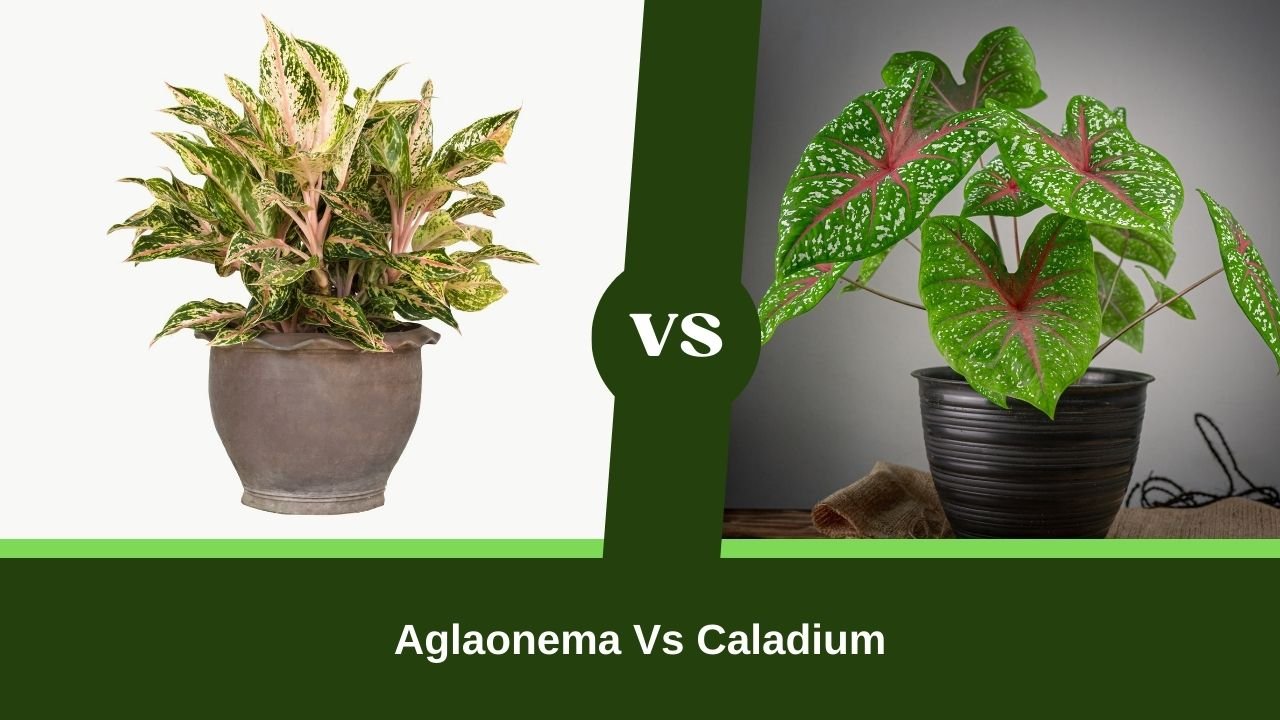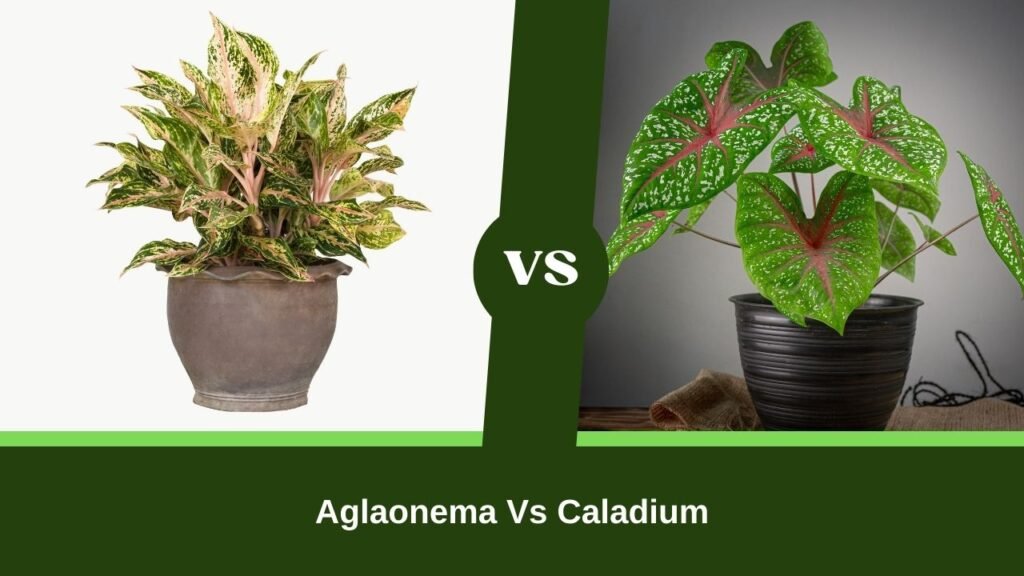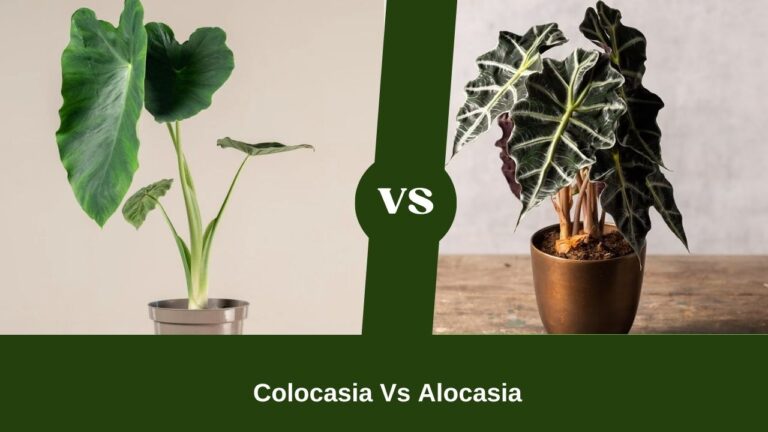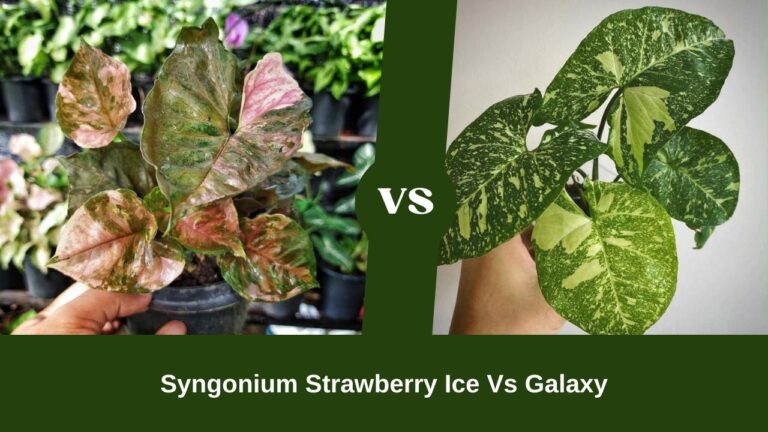Aglaonema Vs Caladium – Aglaonema Is More Adaptable And Elegant!

Aglaonema and Caladium have been stealing the spotlight in recent times for being the most attractive houseplants. But what distinguishes the difference between these two plants?
What are the main differences between Aglaonema vs Caladium? Aglaonema has broad, lance-shaped leaves, while Caladium has heart-shaped or arrowhead-shaped leaves with vibrant patterns. The care is identical, but Aglaonema is a little bit more adoptable and to me, looks elegant as well!
There are some more differences between these two. And we will discuss all of these differences here in this discussion in detail. Continue reading this article without skipping any section. I bet, your decision will be much easier to take after reading this article!

Table of Contents
The Surprising Origins of Aglaonema And Caladium
Both Aglaonema and Caladium trace their roots back to the steamy tropical forests and jungles of Southeast Asia. Aglaonema is native to the dense, humid woodlands of the Philippines, Malaysia, and Indonesia.
Caladium originally hails from the equatorial environs of South America, including regions like Brazil, Bolivia, and the Guianas. Over centuries, these exotic beauties spread across the tropics and eventually beyond to become beloved houseplants.
Though originating in far-flung corners of the map, Aglaonema and Caladium found common footing as adaptable foliage plants beloved for their dramatic leaves and easygoing, rewarding nature.
How Does Leaf Shape Set Aglaonema and Caladium Apart?

One of the most obvious distinguishing features between these two plants appears right on the surface – their leaf shape and structure. Aglaonema varieties are prized for their broad, oblong, or lanceolate-shaped leaves, often emerging in eye-catching rosettes from the base. Mature leaf sizes range anywhere from 4 inches to over 12 inches long.
Meanwhile, Caladium leaves assume a distinct arrowhead or heart-shaped form. They generously span outward on shorter stalks in a lush bush. At maturity, the larger varietals boast leaves spreading 12 inches wide or greater.
So if you want big, bold arrowheads, go with Caladium. For elongated tapered leaves, choose Aglaonema. Either option serves up an outstanding tropical texture.
Related articles:
Are Their Leaf Colors and Patterns Ever Crossed Your Mind?
Beyond shaping, Aglaonema and Caladium foliage diverge in their coloration and patterning too. Aglaonema leaves typically emerge in solid hues or simple variegated mixes of green, silver, gray, red, or yellow. The coloring often appears in striking stripes, spots, or marbling.
But when it comes to vividly kaleidoscopic patterns, few can compete with Caladium. These fanciful leaves showcase wildly imaginative paintbrush strokes of color, with endless permutations of red, pink, white and green. No two leaves ever look the same, resembling living works of abstract art.
For showy, electric leaf patterns, go with Caladium. For more subdued solid colors, opt for Aglaonema. Both choices pump up the visual dynamics indoors.
Do These Tropical Beauties Require Identical Care?
While their aesthetic qualities may differ, you’ll be pleased to know Aglaonema and Caladium share similar easy care requirements. However, a few key differences exist.
Aglaonema happily thrives in moderate to low indirect light. Their willingness to tolerate shadier corners makes them excellently adapted houseplants. Caladium, on the other hand, thrives in brighter filtered light to truly maximize their colorful potential.
Both plants appreciate regularly moist soil during the growing season. But allow Caladium to dry out a bit more between waterings to prevent soggy roots. Aglaonema is more forgiving if accidentally overwatered on occasion.
Additionally, both plants can cause gastric distress if pet fur kids nibble on their foliage, so keep them safely out of paws’ reach. But Caladium’s higher oxalate levels make it ultimately more hazardous if consumed.
How Do Their Growth Habits Compare?
When mature, Aglaonema and Caladium assume quite different growth habits. Aglaonema features upright, sturdy stems reaching anywhere from 18 inches to 4 feet tall depending on the variety. This gives them an excellent vertical presence as focal points.
Meanwhile, Caladium remains more compact and clumping in habit, typically not exceeding 18 inches tall but spreading outward more broadly. Their bushy foliage emerges in a dense rosette pattern from the tuber.
So if you want a bold tower go with Aglaonema, but for shorter yet full plants, choose Caladium. Either way, their lush leaves bring vital vibrance.
How Does Raising These Plants Differ?
Deciding which plant fits your space best depends largely on your unique growing conditions and plant parenthood style.
For lower-light indoor situations, Aglaonema is likely the champion with its tolerance for shadier areas. Caladium relies on ample brightness to show off its brightest colors.
Outdoors, Caladium revels during the warm seasons in partly shady garden beds or planters. Aglaonema accepts outdoor life but really thrives best as a full-time houseplant.
Those in warmer zones will find adaptable Caladium easier for outdoor and indoor cultivation year-round. For cooler households, Aglaonema’s less demanding nature gives it the edge.
When it comes to maintenance, Aglaonema asks less of your time and caregiving attention, making it the lower-effort choice. For those who love a challenge and don’t mind some extra plant pampering, choose lively Caladium.
What Other Traits Unite Caladium And Aglaonema?
Though unique, Aglaonema and Caladium share tropical roots and needs. Both hail from steamy Asian and Indonesian jungles.
They thrive in similar care conditions, from soil to humidity. Their propagating and growth habits are alike too.
Most of all, either plant infuses energizing green elegance indoors. Their dramatic leaves liven up any space. Both readily multiply, allowing you to expand your plant collection.
Let’s Find A Suitable Match..
When deciding between these two kings of tropical foliage, consider a few things will help you to make your decision easily. Here’s my short but precise view on which plant to choose for you.
- If you want leaves with wild, artsy patterns, go with fun-loving Caladium. Let its colorful foliage steal the show!
- Prefer an elegant, tall statement? Choose towering Aglaonema to grab attention.
- For low-light homes, adaptable Aglaonema is your champ. It thrives in shade.
- Caladium excels in bright indoor gardens, letting its colors dazzle.
Last but not least, you can’t go wrong with either beauty! Aglaonema and Caladium both bring joyful energy and beauty indoors through their unique tropical magic.
Conclusion
Rather than declaring one better, appreciate their diversity. Each has special qualities as a houseplant. Aglaonema enchants with spear leaves and resilient adaptability. Caladium dazzles with artsy colors and compact form.
Embracing their differences expands our skills as plant caretakers. We learn ideal conditions for each genus’ uniqueness. Celebrate Caladium’s vibrant colors, and Aglaonema’s stately elegance. Their tropical diversity brings joy while growing our green thumbs.






